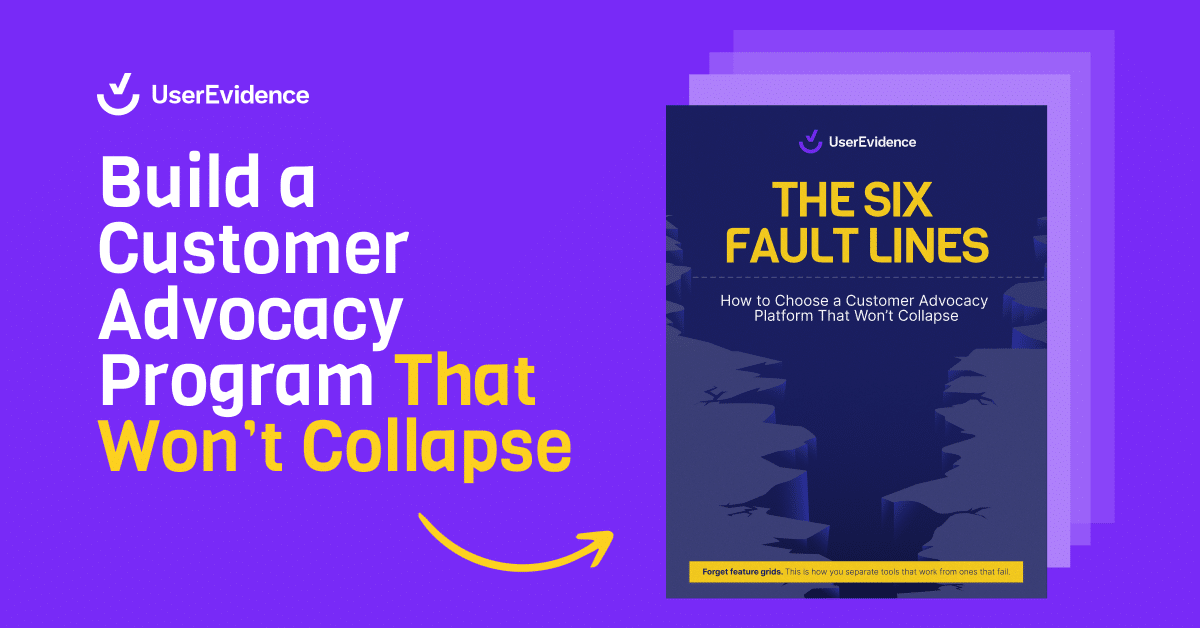Is there anything worse than stalled deals?
Sales starts breathing down your neck. Every meeting turns into a blame game — with fingers pointed at marketing. The go-to question becomes, “Why aren’t we driving urgency?”
And nobody knows the answer.
When deals start stalling, often, the problem isn’t the quality of your product, the creativity of your marketing campaigns, or your team’s ability to pitch.
What’s stalling the sales process is your inability to prove ROI in a way that resonates with risk-averse buyers.
Two stats from our recent original research report that are a tough pill to swallow side-by-side:

…OOF.
That’s the Evidence Gap. If you’re not proving clear, tangible value — and not enabling our sales team to sell that clear, tangible value — your product won’t make it past the shortlist, no matter how innovative it is.
Here’s why:
Buyers are running away from risk
In a turbulent market, buyers tighten up.
With shrinking budgets and increased scrutiny from finance, they stick to what feels safe. That means going with the well-known, established vendors with big names and bigger marketing budgets over taking a chance on a new product.
The old saying goes: “Nobody got fired for buying IBM.” And that’s the reality of today’s B2B market.
That risk-aversion is a pain that sales teams all over B2B are feeling. And it’s the reason that our team has become (healthily) obsessed with the 3 Why’s framework.
In order to make sure we truly understand our buyers’ needs, we need to be able to answer these three questions about them as early in the sales cycle as possible:
- Why anything?
- Why us?
- Why now?
Now, If you’re like me, I guarantee you’ve been in the buyer’s seat and have used the “let’s circle back on this next quarter” line to skirt around some more real conversations regarding the fear you’re feeling. There’s an inherent risk in investing in a newer or more emerging tool or solution, and when it’s our job on the line, we don’t allow much wiggle room for risk.
So, the “why now?” question becomes a lot harder to answer. Because every big decision = big risk. And big risk = less urgency (because no decision is much less risky than the wrong decision).
That’s where ROI comes in.
The ability to share ROI helps us meet the buyer with a very easy answer to the “why now?” question – these are the real business outcomes that others just like you have seen with our solution.
Less risk = more urgency.
The ROI-shaped elephant in the room
Great, so putting some flashy ROI stats on our sales decks should solve all of our problems!
Not so fast.
Buyers are sharp. And they’re seeing through outlandish claims like “438% ROI.” When ROI data feels too broad and too vague, they check out.
And then your deal fades.
Mark Kosoglow, CEO and founder at Operator.ai, feels this from both the buyer’s seat and the seller’s seat – “We have a real legitimacy problem on our hands. I know I rarely believe what a vendor tells me because I’ve seen so many times how these numbers are created”.
OK…but what’s stopping marketers from gathering more customer evidence to even out the ROI stats and tell more realistic data stories? Well, it turns out there’s lots stopping them.
Nine out of 10 marketers wish they could provide more diverse customer evidence to sales. But here’s what’s stalling their efforts:
It’s a time, resourcing, and relationship suck.
Natalie Marcotullio, Head of Growth and Operations at Navattic, shares this sentiment: “Marketers don’t prioritize case studies because it can be so difficult to get ROI data from customers. SaaS is more competitive than ever, so while customers may be happy to talk about their great experience using your software, they may not want to give specific stats that reveal a competitive advantage.”
The solution: Verified ROI
So…are we stuck here?
Nope. The answer to this growing evidence gap is Verified ROI.
Verified ROI is ROI data that is collected and verified by a third-party vendor.
The reason that’s so important? Well, let’s go back to our “438% ROI” claim we talked about earlier. Why do you think nobody believes it? It’s because it sounds outlandish…which means it likely is. We’re not saying that somebody just made up a number and stuck it on their sales deck – what’s more likely is that they took that number from their most successful case study and claimed it as the ROI you can expect.
Truth? Maybe. Realistic? Probably not.
This is where the third-party verification becomes important. By using a third-party to conduct surveys and create an ROI model that your company can build stats out of, your ROI becomes far more valuable to the buyer, because what they see on that pitch deck is literally what they’re going to get.
It’s not the best case scenario.
It’s not the cream of the crop.
It’s the aggregate of the real-deal results, as reported by other buyers.
And, guess what? Buyers trust other buyers.
Nothing builds confidence like hearing it from someone who’s been in their shoes.
The sales process isn’t just about telling buyers what you think your product can do. It’s about showing them what your product has already done – and, what’s more, for as many different use cases and segments as possible.
“Sellers aren’t going to share evidence for a customer that doesn’t mirror their prospect – size, industry, use case, etc.,” Devin Reed, Founder of The Reeder, shares. “That doesn’t de-risk the decision for the buyer, so sellers would rather skip it versus sending something irrelevant and it backfire.”
The more diverse Verified ROI marketers can equip their sales teams with, the less of that dreaded pipeline stall they’ll feel.
Cool…how do I gather Verified ROI?
To gather verified ROI, you’ll need to follow some best practices:
Figure out where proof is needed
First thing’s first – where is your sales team struggling? Are they needing better proof for a certain industry? A specific use case? One of your newer products? Once you identify where proof is needed the most, you can specialize the pool of customers based on that need in order to get the most accurate and realistic data.
Identify your pool and get transparent
Determine how you’ll survey and interview a broad, unbiased sample of the audience that’s going to match the proof points you’re trying to gather. (No, you can’t just survey your champions.) Consider giving this process a budget to properly incentivize as many people to respond as possible. (Need some ideas? We’ve got ‘em.)
Then, when you’re sharing data from that survey with your buyers, give them the full story of where that data came from. Tell them how many customers you surveyed, what industries and use cases they represent, etc. Telling the transparent story proactively in a sales conversation instead of holding your breath that they won’t dig in and ask for specifics is a surefire way to earn trust early.
Conduct third-party interviews and surveys
A quick Google for “survey vendors” should be proof enough that there are plenty of third-party partners out there for you to use (us included). And while Verified ROI must be conducted by a third-party, there are also other ways you can do some in-house work to gather proof points to help tell your story.
Here are some pieces of customer evidence that don’t require a third-party to collect:
- Testimonials
- Customer quotes
- Case Studies
And, of course, un-verified ROI is better than no ROI at all. If the third-party bit is holding you back, conduct your own survey to start gathering those proof points. (If you’re stuck on where to start with your survey, check out some of our favorite templates.)
Analyze the results and get that customer evidence out there
Break down the findings to identify actionable takeaways, and turn those key insights into compelling content for your sales and marketing efforts.
A few ways we love to do this:
- Create a library of graphics with key stats
- Create slides with customer quotes that can live in your preferred sales asset management tool (Seismic, Highspot, etc.) and be easily incorporated into relevant sales decks
- Put your ROI data into a customer library microsite that is easily searchable for your sales team so they can pull relevant customer evidence for the deals they’re working
- Add relevant testimonials to all of your website’s sub-pages (hot take – they don’t all have to live on the same Testimonials sub-page)
Verified ROI = quicker sales cycles
Stalled deals aren’t about your product or pitch—they’re about bridging the Evidence Gap.
Buyers today are cautious and focused on minimizing risk, so they’re not just looking for bold claims; they want real proof of ROI that feels trustworthy.
The key takeaway? Buyers trust other buyers. The more credible, transparent evidence you can share, the more confident your prospects will feel about choosing you over the competition. It’s all about showing them the real-world success your product has already delivered.
Ready to get Verified ROI to move your stalled deals along?
UserEvidence can be your third-party dream team. Check out ROI Studies by UserEvidence.




